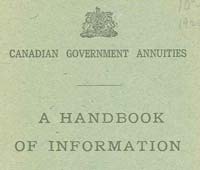When Canada became a nation in 1867, there was no such thing as retirement for the elderly. Primarily an agricultural society at the time, the majority of people in Canada lived on the farm and worked well into their ?golden years." There was no formal national retirement plan, and privately-sold annuities were not readily available. Only when a person was physically unable to do their chores did he or she ?retire," relying upon the goodwill of his or her extended family for financial support.
At the turn of the 20th century, social reformers began pressuring the Canadian government to create an old age pension system for all citizens. The government resisted and, instead, passed, in 1908, the Canadian Government Annuities Act, making it possible to offer annuities to working men and women to help them save for retirement. Though this was a significant breakthrough, the truth of the matter was that very few Canadians could afford to save for or to buy these annuities. Nonetheless, some of the few who could did, and even some employers began to purchase annuities for their employees. These were the earliest examples of pension plans in Canada.
With the advent of the Old Age Security Act in 1952, then the Canada Pension Plan in 1966, the optional government annuities sold under the Canadian Government Annuities Act of 1908 became somewhat superfluous, and the sale of these annuities was stopped in 1975. To this day, however, the Annuities Branch, an agency of the federal government, administers annuities payable to Canadians. Employers were allowed to register their employees up until 1979, and so although Canadian Government Annuities are a thing of the past, they will be supporting Canadians through their golden years for years to come.


